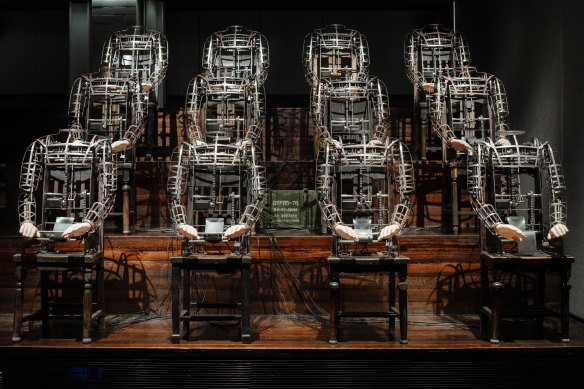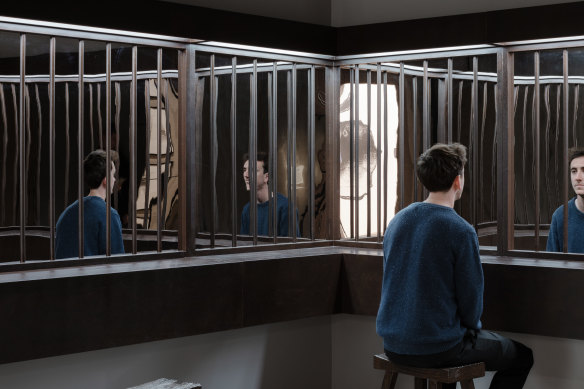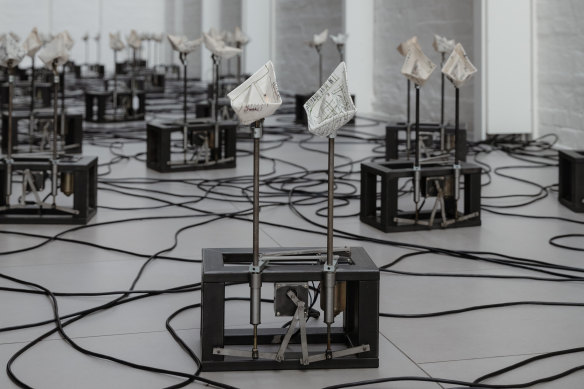Save articles for later
Add articles to your saved list and come back to them any time.
In China, art is constantly flirting with politics. It’s a game of approach and retreat everywhere in evidence in the new White Rabbit exhibition, I Am the People, which features 27 artists or groups of artists. It’s one of curator David Williams’s most ambitious, most overtly political shows – perhaps not as attractive or spectacular as some of the gallery’s previous surveys of contemporary Chinese art, but it cuts deep.
The essential theme of the exhibition could be seen as the tension between the public and private realms in a nation that has historically put collective experience above that of the individual. As late as the 1990s it was common to read that individualism was an entirely new concept in China, but as living standards and consumer choices have escalated, group-think has withered away.
In Mao’s time, everybody was nominally equal, even though party officials enjoyed privileges not available to ordinary people. In today’s China, there are gigantic variations in wealth, from billionaire entrepreneurs to peasants. The only times these individuals come together may be for large sporting events or national celebrations. The tensions between the collective and the individual reflect the schizoid politics of a communist country with a market economy. Such tensions have been exacerbated by the experience of COVID-19 and the heavy-handed lockdowns that caused widespread unrest.
Liu Chang’s Chorus (2021).Credit: Hamish McIntosh
The show begins on a wistful note with Shyu Ruey-Shiann’s River of Childhood (2011), an installation that features 80 small ceramic boats attached to motors that make them bob like paper vessels on a pond. Shyu has made no attempt to aestheticise the work: his motors are crude, boxy affairs, connected to cables that snake across the floor. The self-absorbed play of childhood – think of Chardin’s boy playing with a top! – has been transformed into a mechanical process, although the only things being produced are the artist’s memories.
There’s a similar sense of nostalgia on Level One, in Gao Rong’s life-sized, embroidered facsimiles of a doorway, exposed pipes, a sink with dishes, and a standing bus sign. Nothing could be more humdrum than these items, which inhabit a conceptual space somewhere between sculpture and stage design. If they make viewers gasp in astonishment it’s because of the painstaking care Gao has taken to reproduce every dirty smudge, every fleck of rust with needle and thread.
Level 1/2, Unit 8, Building 5, Hua Jiadi, North Village (2010), is an exact replica of the entrance to an apartment the artist rented during her student days. Given the speed with which Beijing has been redeveloped over the past two decades, it’s unlikely this doorway, or even the building remains intact. Gao has preserved a fragment of personal history while the nation and its capital have moved on.
On this same floor one finds photos of the Uyghur people by Hailun Ma; images of prisoners held in camps in northern Myanmar, by Lu Nan; and videos of factory workers by Li Xiaofei. These distinct bodies of work share one aim: to put faces to those who are otherwise invisible to us.
Yang Zhenzhong’s Fences (2013).Credit: Hamish McIntosh
Most people in China have no first-hand experience of Xinjiang province and know the Uyghurs only as migrant workers. Hailun’s crisp colour portraits show them in national dress, as skateboarders and even cowboys. It breaks down the monolithic image of a group into a set of highly personalised roles.
Lu Nan, reputedly the only Chinese photographer to have worked for the Magnum agency, focuses on a group of prisoners, mainly drug offenders, in a camp across the border from Yunnan. They are kept in cages, chains around their ankles. An imaginative installation obliges us to peer through bars to see the photographs, emphasising the distance between ourselves and these impassive, stoic faces. This arrangement finds an echo in a larger installation by Yang Zhenzhong, which wraps itself around two walls. We experience this piece, Fences (2013), by sitting to look through a row of bars, only to see our own reflection.
Li Xiaofei’s videos capture another kind of prison – the repetitive rhythms of manufacturing, in large factories or on a modest, domestic scale. Most of the things we use and take for granted, are the product of someone’s labour. Li exposes that labour and the social world of the workers in brief, deadpan films that also reveal his fascination with the industrial sublime and the shiny glamour of the machine, as explored by the Bauhaus photographers, and in Australia by Wolfgang Sievers.
Faced with Li’s persevering workers it’s impossible not to think of those heroic, muscular figures in the propaganda art of the Mao era, all grinning insanely at the thought they are building socialism by working in a factory. The collective ideal seems foolish in the face of mundane reality.
Shyu Ruey-Shiann’s River of Childhood.Credit: Hamish McIntosh
As usual with White Rabbit shows, there is a significant painting component, from Ge Hui’s awkward compositions featuring rubbery, elongated figures that stare blankly back at us, to Ouyang Chun’s Creamcake, Lighthouse, Skyscrapers or Shimmering Anthill (2017). In the latter, the title reflects the ambiguities of a large, complex picture with multiple identities.
According to the catalogue, Ge’s languid, boneless figures are known “for their expression of longing and a sense of strangeness that defies categorisation.” If I were to attempt a categorisation, I’d say these characters looked decadent and alienated, as if they had nothing better to do than lounge around and strike poses. Once again nothing could be further from the crisp purposeful figures of the 1970s, so proud of their roles as workers, soldiers or peasants.
That alienated mood is carried over to the third floor, which is usually reserved for some breathtaking highlight. This time we are met with three installations by Chen Wei, best known for his unusual, melancholy photographs that manage to feel both familiar and strange. In History of Enchantment (Cold Sculpture), Shanghai (2015) Chen has created seven stainless-steel forms that resemble elements of architecture or furniture. In a darkened gallery, these forms reflect the flickering colours of two other bodies of work: Where are you going tonight? (2023), a carefully arranged stack of LED screens with fragments of text and colour; and In the Waves (2013), a suite of ink-jet prints showing young people engulfed by the lurid haze of nightclubs.
It’s a low-key finale for an exhibition that paints an unsettling picture of a China that has lost touch with its past and its future. Whether they are staring from behind bars, working patiently in factories, or swaying mindlessly in dance clubs, most of the people in this show seem adrift in the present, lacking spirit or belief. While nobody subscribes to the communist utopia any longer, consumer society is merely one long parade of ephemeral desires. Art anxiously holds up a mirror to a society without politics – or rather, without a vigorous political process whereby different creeds and values can contend with one another. In China, there is only the party line and the all-powerful, paternalistic state. All the shopping and entertainment in the world can’t compensate for this zombification of the heart and mind.
I Am the People is at the White Rabbit Gallery until November 12.
Most Viewed in Culture
From our partners
Source: Read Full Article










